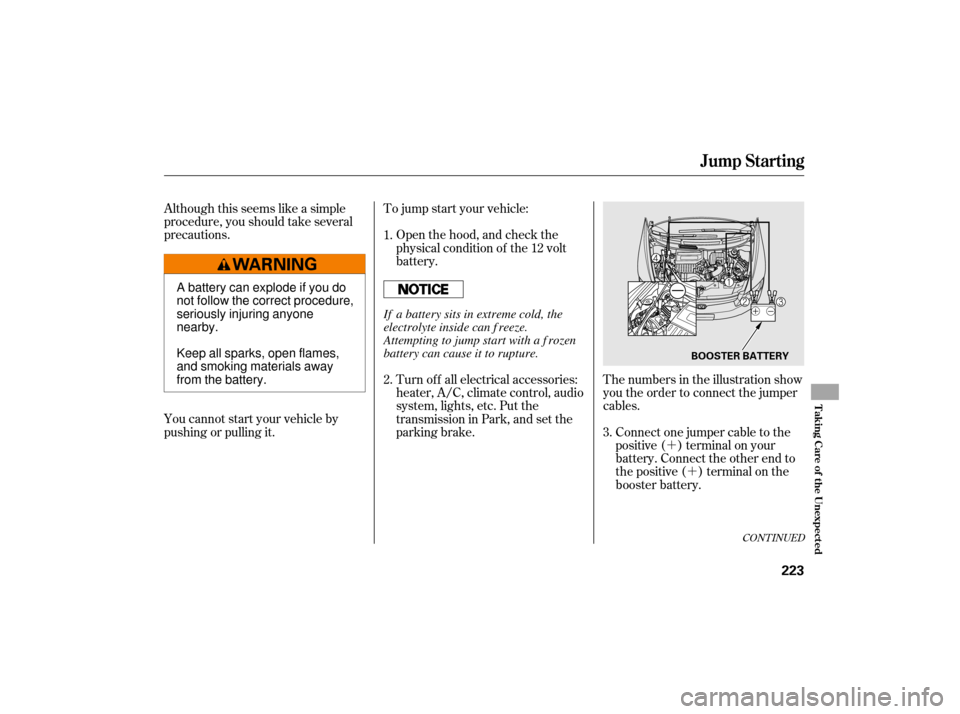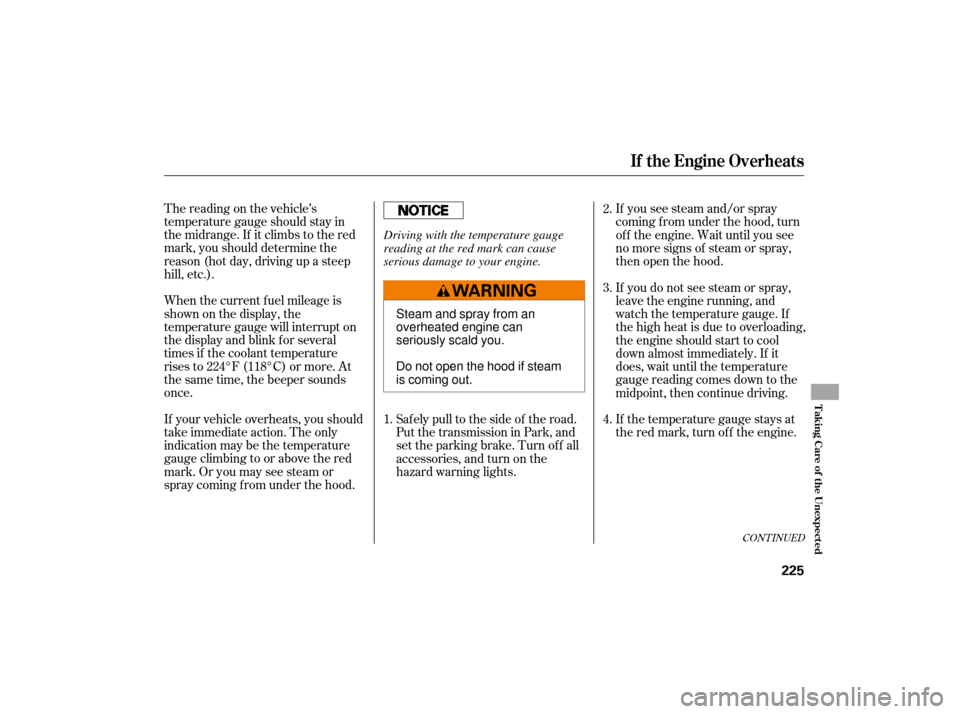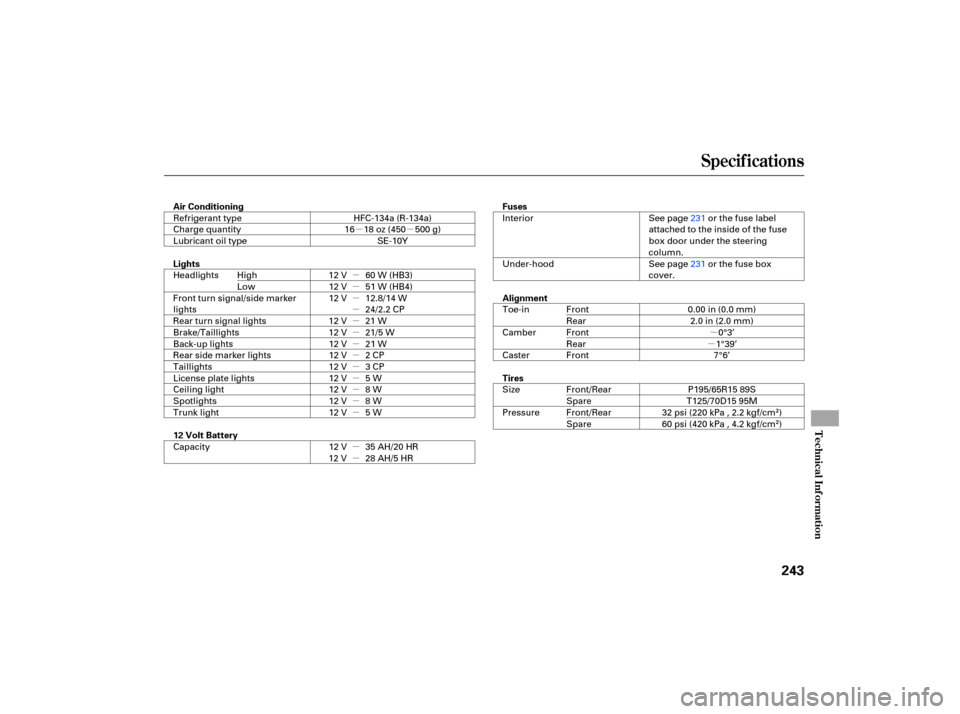Page 205 of 268
Pull the bulb straight out of its
socket. Push the new bulb straight
into the socket until it bottoms.
Insert the socket back into the
light assembly. Turn it clockwise
to lock it in place.
Push the trunk lid trim back into
position.
Put the f asteners into the holes on
the trunk lid trim. Reinstall the
screws.Beforeusinganautomaticcarwash,
remove the radio antenna so it does
not get damaged. Remove the
antenna by unscrewing it. When you
reinstall the antenna, tighten it
securely.
Bef ore entering or parking in areas
with low ceiling height, remove the
antenna.
Turn on the lights to make sure
the new bulb is working.
Remove the socket by turning it
one-quarter turn counterclockwise.
2. 3.
4.
5.
6.
7.
Roof A ntenna
Lights, Roof Antenna
202
BULB
SOCKET
Page 220 of 268
CONT INUED
If you have a f lat tire while driving,
stop in a saf e place to change it.
Drive slowly along the shoulder until
you get to an exit or an area to stop
that is far away from the traffic lanes.Park the vehicle on f irm, level, and
non-slippery ground. Put the
transmission in Park. Apply the
parking brake.Open the trunk. Raise the trunk
f loor by lif ting up on the back edge.
Turn on the hazard warning lights,
and turn the ignition switch to the
LOCK (0) position. Have all
passengers get out of the vehicle
while you change the tire. Take the tool case out of the spare
tire.
Unscrew the wing bolt and take
the spare tire out of its well.
5. 4.
3.
2. 1.
Changing a Flat Tire
T aking Care of t he Unexpect ed
217
JACK
SPARE TIRE
TRUNK FLOOR TOOL CASE
The vehicle can easily roll off
the jack, seriously injuring
anyone underneath.
Follow the directions for
changing a tire exactly, and
never get under the vehicle
when it is supported only by the
jack.
Page 224 of 268

Diagnosing why the engine won’t
start falls into two areas, depending
on what you hear when you turn the
ignition switch to the START (III)
position:
If the headlights dim noticeably or
go out when you try to start the
engine, either the battery is
discharged or the connections are
corroded. Check the condition of
the 12 volt battery and terminal
connections (see page ). You
canthentryjumpstartingthe
vehicle from a booster battery
(see page ).
You
hear nothing, or almost
nothing. The engine’s starter
motor does not operate at all, or
operates very slowly.
You can hear the starter motor
operating normally, or the starter
motor sounds like it is spinning
faster than normal, but the engine
does not start up and run. Wh
en you turn the ignition switch to
the START (III) position, you do not
hear the normal noise of the engine
trying to start. You may hear a
clicking sound, a series of clicks, or
nothing at all.
Check these things:
Check the transmission interlock.
The transmission must be in Park
or neutral or the starter will not
operate. Turn
the ignition switch to the
START (III) position. If the
headlights do not dim, check the
condition of the fuses. If the fuses
areOK,thereisprobably
something wrong with the
electrical circuit for the ignition
switch or starter motor. You will
need a qualified technician to
determine the problem. See
on page .
Turn the ignition switch to the ON
(II) position. Turn on the
headlights, and check their
brightness. If the headlights are
very dim or do not come on at all,
the battery is discharged. See
on page . 223 223212237
Nothing Happens or the Starter
Motor Operates Very Slowly
Emergency T owing
Jump Starting
If theEngineWon’tStart
T aking Care of t he Unexpect ed
221
Page 226 of 268

�´�´
Although this seems like a simple
procedure, you should take several
precautions.
To jump start your vehicle:
The numbers in the illustration show
you the order to connect the jumper
cables.Connect one jumper cable to the
positive ( ) terminal on your
battery. Connect the other end to
the positive ( ) terminal on the
booster battery.
You cannot start your vehicle by
pushing or pulling it. Open the hood, and check the
physical condition of the 12 volt
battery.
Turn of f all electrical accessories:
heater, A/C, climate control, audio
system, lights, etc. Put the
transmission in Park, and set the
parking brake.
1.
2.
3.
CONT INUED
Jump Starting
T aking Care of t he Unexpect ed
223
BOOSTER BATTERY
A battery can explode if you do
not follow the correct procedure,
seriously injuring anyone
nearby.
Keep all sparks, open flames,
and smoking materials away
from the battery.If a battery sits in extreme cold, the
electrolyte inside can f reeze.
Attempting to jump start with a f rozen
battery can cause it to rupture.
Page 228 of 268

The reading on the vehicle’s
temperature gauge should stay in
the midrange. If it climbs to the red
mark, you should determine the
reason (hot day, driving up a steep
hill, etc.).
When the current f uel mileage is
shownonthedisplay,the
temperature gauge will interrupt on
the display and blink for several
times if the coolant temperature
rises to 224°F (118°C) or more. At
the same time, the beeper sounds
once.
If your vehicle overheats, you should
take immediate action. The only
indicationmaybethetemperature
gauge climbing to or above the red
mark. Or you may see steam or
spray coming f rom under the hood.If you see steam and/or spray
coming f rom under the hood, turn
of f the engine. Wait until you see
no more signs of steam or spray,
then open the hood.
If you do not see steam or spray,
leave the engine running, and
watch the temperature gauge. If
the high heat is due to overloading,
the engine should start to cool
down almost immediately. If it
does, wait until the temperature
gauge reading comes down to the
midpoint, then continue driving.
If the temperature gauge stays at
the red mark, turn of f the engine.
Saf ely pull to the side of the road.
Put the transmission in Park, and
set the parking brake. Turn of f all
accessories, and turn on the
hazard warning lights.
1. 2.
3.
4.
CONT INUED
If theEngineOverheats
T aking Care of t he Unexpect ed
225
Steam and spray from an
overheated engine can
seriously scald you.
Do not open the hood if steam
is coming out.
Driving with the temperature gauge
reading at the red mark can cause
serious damage to your engine.
Page 230 of 268

If necessary, add oil to bring the
level back to the full mark on the
dipstick (see page ).
This
indicator should never
come on when the engine is
running. If it starts flashing
or stays on, the oil pressure has
dropped very low or lost pressure.
Serious engine damage is possible,
and you should take immediate
action. The
engine running generates the oil
pressure. When the Auto Idle Stop is
acti vated, the engine is stopped, the
oil pressu re is dropped, and the low
oil pressu re indicator does not come
on.
Safely
pull off the road, and shut
off the engine. Turn on the hazard
warning lights.
Let the vehicle sit for a minute.
Op en the hood, and check the oil
level (see page ). An engine
very low on oil can lose pressure
during cornering and other driving
maneuvers.
Start the engine and watch the oil
pressure indicator. If it does not go
out within 10 seconds, turn off the
engine. There is a m echanical
problem that needs to be repaired
bef ore you can continue driving
(see on page
).
1.
2.
3.
4.
153
189
237
L ow Oil Pressure Indicator
Emergency T owing
T aking Care of t he Unexpect ed
227
Running the engine with low oil
pressure can cause serious mechanical
damage almost immediately. Turn of f
the engine as soon as you can saf ely get
the vehicle stopped.
Page 235 of 268
Turn the ignition switch to the
LOCK (0) position. Make sure the
headlights and all oth er
accessories are off.
Remove the cover from the fuse
box.
If
something electrical in your
vehicle stops working, the first thing
youshouldcheckforisablownfuse.
Determine f rom the chart on pages and , or the diagram on the
fuse box lid, which fuse or fuses
control that device. Check those
f uses f irst, but check all the f uses
bef ore deciding that a blown f use is
the cause. Replace any blown f uses,
and check if the device works.
Check each of the large f uses in
the primary under-hood f use box
by looking through the top at the
wire inside. Remove the screws
with a Phillips-head screwdriver.
1.
2. 3.
235
236
Checking and Replacing Fuses
Fuses
232
BLOWN
FUSE BLOWN
Page 246 of 268

�µ�µ�µ�µ
�µ
�µ
�µ
�µ
�µ
�µ
�µ
�µ
�µ
�µ
�µ
�µ
�µ
�µ
�µ
Specifications
T
echnical Inf ormat ion
243
Air Conditioning Fuses
Alignment
12 Volt Battery Tires
Lights
HFC-134a
(R-134a)
16 18 oz (450 500 g)
SE-10Y
12 V 60 W
12 V 3 CP
12
V 21/5 W
12
V 21 W
7°6’1°39’ 0°3’
0.00
in (0.0 mm)
P195/65R15 89S
2.0
in (2.0 mm)
Refrigerant
type
Charge quantity
Lubricant oil type Interior
Under-hood
Toe-in
Camber
Caster
12
V 12.8/14 W
12
V 51 W
12 V 21 W
12 V
12 V
12 V
12 V 5W
8W
8W
5W
Capacity 12 V 35 AH/20 HR T125/70D15
95M
32 psi (220 kPa , 2.2 kgf/cm
)
60 psi (420 kPa , 4.2 kgf/cm)
Size
Pr
essure
12
V 2 CP See
page 231 or the fuse label
attached to the inside of the fuse
box door under the steering
column.
See page 231 or the fuse box
cover.
Headlights
Front turn signal/side marker
lights
Rear turn signal lights
Brake/Taillights
Back-up lights
Rear side marker lights
Taillights
License plate lights
Ceiling light
Spotlights
Trunk light
12 V 28 AH/5 HR24/2.2 CP Front
Rear
Front
Rear
Front
High
Low
(HB3)
(HB4)
Front/Rear
Spare
Front/Rear
Spare